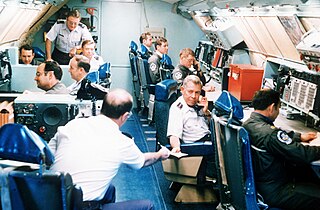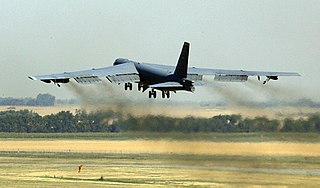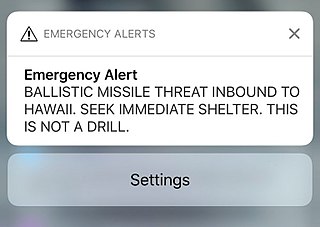 W
WThe 1st Airborne Command Control Squadron is part of the 595th Command and Control Group at Offutt Air Force Base, Nebraska. It operates the Boeing E-4 aircraft conducting airborne command and control missions.
 W
WThe United States Air Force's 2d Airborne Command and Control Squadron was an airborne command and control unit located at Offutt Air Force Base, Nebraska. The squadron was an integral part of the United States' Post Attack Command and Control System, performing the Operation Looking Glass mission with the Boeing EC-135 aircraft.
 W
WOn 29 August 2007, six AGM-129 ACM cruise missiles, each loaded with a W80-1 variable yield nuclear warhead, were mistakenly loaded onto a United States Air Force (USAF) B-52H heavy bomber at Minot Air Force Base in North Dakota and transported to Barksdale Air Force Base in Louisiana. The nuclear warheads in the missiles were supposed to have been removed before the missiles were taken from their storage bunker. The missiles with the nuclear warheads were not reported missing, and remained mounted to the aircraft at both Minot and Barksdale for 36 hours. During this period, the warheads were not protected by the various mandatory security precautions for nuclear weapons.
 W
WAir Force Global Strike Command (AFGSC) is a Major Command (MAJCOM) of the United States Air Force, headquartered at Barksdale Air Force Base, Louisiana. AFGSC provides combat-ready forces to conduct strategic nuclear deterrence and global strike operations in support of combatant commanders. Air Force Global Strike Command is the Air Force's service component to the United States Strategic Command (USSTRATCOM).
 W
WThe United States military's Air Force Satellite Communications (AFSATCOM) is a network of ground and space systems to allow rapid dissemination of communications to a worldwide audience. AFSATCOM's creation was during the height of the Cold War to guarantee that Emergency Action Messages would be received by Strategic Air Command nuclear forces.
 W
WAir Force Space Command (AFSPC) was a major command of the United States Air Force from September 1982 to December 2019. On 20 December 2019, concurrent with the signing of the National Defense Authorization Act for 2020, it was re-designated as the United States Space Force and became a new sixth service branch of the United States Armed Forces responsible for space warfare.
 W
WAirborne Launch Control Centers provide a survivable launch capability for the United States Air Force's LGM-30 Minuteman Intercontinental Ballistic Missile (ICBM) force by utilizing the Airborne Launch Control System (ALCS) onboard which is operated by an airborne missileer crew. Historically, from 1967–1998, the ALCC mission was performed by United States Air Force Boeing EC-135 command post aircraft. This included EC-135A, EC-135C, EC-135G, and EC-135L aircraft.
 W
WThe Airborne Launch Control System (ALCS) provides a survivable launch capability for the United States Air Force's LGM-30G Minuteman III intercontinental ballistic missile (ICBM) force. The ALCS is operated by airborne missileers from Air Force Global Strike Command's (AFGSC) 625th Strategic Operations Squadron (STOS) and United States Strategic Command (USSTRATCOM). The weapon system is located on board the United States Navy's E-6B Mercury, which serves as USSTRATCOM's "Looking Glass" Airborne Command Post (ABNCP). The ALCS crew is integrated into the ABNCP battle staff and is on alert around the clock.
 W
WThe Boeing E-4 Advanced Airborne Command Post (AACP), the current "Nightwatch" aircraft, is a strategic command and control military aircraft operated by the United States Air Force (USAF). The E-4 series are specially modified from the Boeing 747-200B for the National Emergency Airborne Command Post (NEACP) program. The E-4 serves as a survivable mobile command post for the National Command Authority, namely the President of the United States, the Secretary of Defense, and successors. The four E-4Bs are operated by the 1st Airborne Command and Control Squadron of the 595th Command and Control Group located at Offutt Air Force Base, near Omaha, Nebraska. An E-4B when in action is denoted a "National Airborne Operations Center".
 W
WThe Boeing E-6 Mercury is an airborne command post and communications relay based on the Boeing 707. The original E-6A manufactured by Boeing's defense division entered service with the United States Navy in July 1989, replacing the EC-130Q. This platform, now modified to the E-6B standard, conveys instructions from the National Command Authority to fleet ballistic missile submarines, a mission known as TACAMO. The E-6B model deployed in October 1998 also has the ability to remotely control Minuteman ICBMs using the Airborne Launch Control System. The E-6B replaced Air Force EC-135Cs in the "Looking Glass" role, providing command and control of U.S. nuclear forces should ground-based control become inoperable. With production lasting until 1991, the E-6 was the final new derivative of the Boeing 707 to be built.
 W
WFracture Jaw was a top-secret U.S. military contingency plan in which General William C. Westmoreland sought to ensure that nuclear weapons would be available for use in the Vietnam War. The plan included moving nuclear weapons into South Vietnam so that they could be used on short notice against North Vietnamese troops. In spite of moves towards activating the plan, the project was abandoned in February 1968 when it was discovered by the White House.
 W
WOn the morning of Saturday, January 13, 2018, a ballistic missile alert was accidentally issued via the Emergency Alert System and Commercial Mobile Alert System over television, radio, and cellphones in the state of Hawaii. The alert stated that there was an incoming ballistic missile threat to Hawaii, advised residents to seek shelter, and concluded: "This is not a drill". The message was sent at 8:07 a.m. local time. Civil defense outdoor warning sirens were authorized and sounded by the state.
 W
WLooking Glass is the code name for an airborne command and control center operated by the United States. In more recent years it has been more officially referred to as the ABNCP. It provides command and control of U.S. nuclear forces in the event that ground-based command centers have been destroyed or otherwise rendered inoperable. In such an event, the general officer aboard the Looking Glass serves as the Airborne Emergency Action Officer (AEAO) and by law assumes the authority of the National Command Authority and could command execution of nuclear attacks. The AEAO is supported by a battle staff of approximately 20 people, with another dozen responsible for the operation of the aircraft systems. The name Looking Glass, which is another name for a mirror, was chosen for the Airborne Command Post because the mission operates in parallel with the underground command post at Offutt Air Force Base.
 W
WA launch control center (LCC), in the United States, is the main control facility for intercontinental ballistic missiles (ICBMs). A launch control center monitors and controls missile launch facilities. From a launch control center, the missile combat crew can monitor the complex, launch the missile, or relax in the living quarters. The LCC is designed to provide maximum protection for the missile combat crew and equipment vital to missile launch. Missile silos are common across the midwestern United States, and over 450 missiles remain in US Air Force (USAF) service.
 W
WMissile Master was a type of US Army Missile Command military installation for the Cold War Project Nike, each which were a complex of systems and facilities for surface-to-air missile command and control. Each Missile Master had a nuclear bunker housing the Martin AN/FSG-1 Antiaircraft Defense System, as well as additional "tactical structures" for "an AN/FPS-33 defense acquisition radar (DAR) or similar radar, two height-finder radars," and identification friend or foe secondary radar. The radars, along with Automated Data Links (ADL) from remote Nike firing units, provided data into the AN/FSG-1 tracking subsystem with the DAR providing surveillance coverage to about 200 mi (320 km).
 W
WThe National Military Command Center (NMCC) is a Pentagon command and communications center for the National Command Authority. Maintained by the Department of the Air Force as the "DoD Executive Agent" for NMCC logistical, budgetary, facility and systems support; the NMCC operators are in the Joint Staff's J-3 (Operations) Directorate. "The NMCC is responsible for generating Emergency Action Messages (EAMs) to missile launch control centers, nuclear submarines, recon aircraft and battlefield commanders".
 W
WThe nuclear football is a briefcase, the contents of which are to be used by the President of the United States to authorize a nuclear attack while away from fixed command centers, such as the White House Situation Room. It functions as a mobile hub in the strategic defense system of the United States. It is held by an aide-de-camp.
 W
WOffutt Air Force Base is a U.S. Air Force base south of Omaha, adjacent to Bellevue in Sarpy County, Nebraska. It is the headquarters of the U.S. Strategic Command (USSTRATCOM), the 557th Weather Wing, and the 55th Wing of the Air Combat Command (ACC), the latter serving as the host unit.
 W
WOperation Chrome Dome was a United States Air Force Cold-War era mission from 1960 to 1968 in which B-52 Stratofortress strategic bomber aircraft armed with thermonuclear weapons remained on continuous airborne alert, flying routes to points on the Soviet Union border.
 W
WOperation Giant Lance was an undercover military operation by the United States in which the primary objective was to apply military pressure towards the Soviet Union during the Cold War.. Initiated on October 27th, 1969, President Richard Nixon authorized a squadron of 18 B-52 bombers to patrol the glacier caps around Moscow and escalate the nuclear threat poised. The goal was to coerce both the Soviet Union and North Vietnam to agree on favourable terms with the US, and conclusively end the Vietnam war. The operation’s effectiveness was also largely built on Nixon’s consistent madman theory diplomacy, in order to influence Moscow’s decision even more. The operation was kept top secret from both the general public and higher authorities within the Strategic Air Command, intended to only be noticed by Russian intelligence. The operation lasted one month before being called off.
 W
WOperation Power Flite was a United States Air Force mission in which three Boeing B-52 Stratofortresses became the first jet aircraft to circle the world nonstop, when they made the journey in January 1957 in 45 hours and 19 minutes, using in-flight refueling to stay aloft. The mission was intended to demonstrate that the United States had the ability to drop a hydrogen bomb anywhere in the world.
 W
WThe Post Attack Command and Control System (PACCS) was a network of communication sites for use before, during and after a nuclear attack on the United States. PACCS was designed to ensure that National Command Authority would retain sole, exclusive, and complete control over US nuclear weapons. Among other components, it included Strategic Air Command assets such as the Looking Glass aircraft and mission, and various hardened command and control facilities.
 W
WA Permissive Action Link (PAL) is an access control security device for nuclear weapons. Its purpose is to prevent unauthorized arming or detonation of the nuclear weapon. The United States Department of Defense definition is:A device included in or attached to a nuclear weapon system to preclude arming and/or launching until the insertion of a prescribed discrete code or combination. It may include equipment and cabling external to the weapon or weapon system to activate components within the weapon or weapon system.
 W
WThe Post Attack Command and Control System (PACCS) was a network of communication sites for use before, during and after a nuclear attack on the United States. PACCS was designed to ensure that National Command Authority would retain sole, exclusive, and complete control over US nuclear weapons. Among other components, it included Strategic Air Command assets such as the Looking Glass aircraft and mission, and various hardened command and control facilities.
 W
WPost-Attack Command and Control System Facility, Hadley is a defunct Post-Attack Command and Control System facility that operated from June 2, 1958 until 1970. It is located on and under Bare Mountain in Hadley, Massachusetts. The facility was known by many different names: 8th Air Force Combat Operations Center (COC), "The Notch", and "Westover Communications Annex" since it was related to nearby Westover Air Force Base.
 W
WThe Primary Alerting System (PAS), was a network of land-line connections used by the Strategic Air Command (SAC) for command and control of its nuclear forces. PAS provided immediate and simultaneous voice communications to all (SAC) unit command posts and missile launch control facilities.
 W
WThe United States Air Force's Rapid Execution and Combat Targeting System (REACT) is a modification of the LGM-30 Minuteman launch control centers (LCC's) that provides continual monitoring and rapid retargeting of Minuteman ICBMs. It integrates communication systems and weapon systems into a single console.
 W
WThe Raven Rock Mountain Complex (RRMC), also known as Site R, is a U.S. military installation with an underground nuclear bunker near Blue Ridge Summit, Pennsylvania, at Raven Rock Mountain that has been called an "underground Pentagon". The bunker has emergency operations centers for the United States Army, Navy, Air Force and United States Marine Corps. Along with Mount Weather Emergency Operations Center in Virginia and the Cheyenne Mountain Complex in Colorado, it formed the core bunker complexes for the US Continuity of Government plan during the Cold War to survive a nuclear attack.
 W
WThe Selfridge AFB radar station is a United States military facility in Michigan. It began operations in 1949 with a Bendix AN/CPS-5 Radar test that tracked aircraft at 210 mi (340 km). A height finder MIT AN/CPS-4 Radar was added by March 9, 1950; and the station was site L-17 of the Lashup Radar Network and site LP-17 of the subsequent network during construction of the Air Defense Command permanent network. The 661st Aircraft Control and Warning Squadron was activated at Selfridge in 1951, and with a pair of General Electric AN/CPS-6 Radars, the station became site LP-20 of the permanent ADC network in 1952. In 1957 the station added a height finder General Electric AN/FPS-6 Radar. The station became part of the Semi Automatic Ground Environment radar network in 1959, supplying radar tracks to SAGE data center DC-06 at Custer Air Force Station, Michigan, for directing interceptor aircraft and CIM-10 Bomarc air defense missiles.
 W
WThe Single Integrated Operational Plan (SIOP) was the United States' general plan for nuclear war from 1961 to 2003. The SIOP gave the President of the United States a range of targeting options, and described launch procedures and target sets against which nuclear weapons would be launched. The plan integrated the capabilities of the nuclear triad of strategic bombers, land-based intercontinental ballistic missiles (ICBM), and sea-based submarine-launched ballistic missiles (SLBM). The SIOP was a highly classified document, and was one of the most secret and sensitive issues in U.S. national security policy.
 W
WTACAMO is a United States military system of survivable communications links designed to be used in nuclear warfare to maintain communications between the decision-makers and the triad of strategic nuclear weapon delivery systems. Its primary mission is serving as a signals relay, where it receives orders from a command plane such as Operation Looking Glass, and verifies and retransmits their Emergency Action Messages (EAMs) to US strategic forces. As it is a dedicated communications post, it features the ability to communicate on virtually every radio frequency band from very low frequency (VLF) up through super high frequency (SHF) using a variety of modulations, encryptions and networks, minimizing the likelihood an emergency message will be jammed by the enemy. This airborne communications capability largely replaced the land-based extremely low frequency (ELF) broadcast sites which became vulnerable to nuclear strike.
 W
WTinker Air Force Base is a major United States Air Force base, with tenant U.S. Navy and other Department of Defense missions, located in Oklahoma County, Oklahoma, surrounded by Del City, Oklahoma City, and Midwest City.
 W
WUnited States Strategic Command (USSTRATCOM) is one of the eleven unified combatant commands in the United States Department of Defense. Headquartered at Offutt Air Force Base, Nebraska, USSTRATCOM is responsible for strategic deterrence, global strike, and operating the Defense Department's Global Information Grid. It also provides a host of capabilities to support the other combatant commands, including integrated missile defense; and global command, control, communications, computers, intelligence, surveillance, and reconnaissance (C4ISR). This command exists to give national leadership a unified resource for greater understanding of specific threats around the world and the means to respond to those threats rapidly.
 W
WWeapons Storage and Security System (WS3) is a system including electronic controls and vaults built into the floors of Protective Aircraft Shelters (PAS) on several United States and NATO military airfields all over the world. These vaults are used for safe special weapons storage, typically of tactical B61 nuclear bombs. Historically the system was also called within NATO the Weapon Security and Survivability System (WS3) or Weapons Survivability and Security System.
 W
WThe Western Electric System 1393 Radar Course Directing Central (RCDC) was a Cold War complex of radar/computer systems within the overall Improved Nike Hercules Air Defense Guided Missile System. The RCDC was installed at the "battery control areas" of ~5 hectares each which was for commanding a nearby missile Launching Area (LA), firing a missile from the LA, and guiding a launched missile to a burst point near an enemy aircraft.